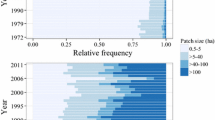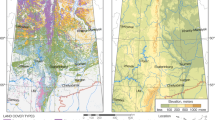Abstract—
The climate change that has taken place in recent decades has significantly increased the threat of the occurrence and distribution of wildfires in northwestern Siberia. However, little is known about the spatial and temporal patterns of fires and their relationship with climate and vegetation in this area. As a result of processing Landsat satellite images for 1985–2017, it was determined that 10.5% of the Western Siberia forest tundra was exposed to fires. The maximum relative area of burned forests (23%) was found in larch and spruce–larch lichen woodlands. One geobotanical indicator of increased fire hazard is the dominance of synusiae of epigeic lichens in the vegetation cover. It is shown that most of the severely burned areas were distributed in the central part of the forest tundra within the largest gas fields. Our results have shown a positive significant correlation between square of areas burned and summer temperature regime (average and maximum summer temperatures) and a negative correlation between burned areas and the amount of summer precipitation. A dendrochronological analysis showed that the frequency of fires varied from 15 to 60 years (an average of about 30 years).




Similar content being viewed by others
REFERENCES
Adaev, V.N., Smoke over the taiga and tundra: fire in the culture of the northern peoples of Western Siberia as a tool for environment transformation, Vestn. Arkheol., Antropol. Etnogr., 2018, no. 2 (41), pp. 138–147.
Allen, J.L. and Sorbel, B., Assessing the differenced Normalized Burn Ratio’s ability to map burn severity in the boreal forest and tundra ecosystems of Alaska’s national parks, Int. J. Wildland Fire, 2008, vol. 17, pp. 463–475.
Aref’ev, S.P., Assessment of the stability of the Siberian stone pine forests in the Western Siberian plain, Russ. J. Ecol., 1997, vol. 28, no. 3, pp. 149–157.
Atlas Yamalo-Nenetskogo avtonomnogo okruga (Atlas of Yamal-Nenets Autonomous Okrug), Omsk: Omsk. Kartogr. Fabrika, 2004.
Bartalev, S.A., Egorov, V.A., Efremov, V.Yu., Lupyan, E.A., Stytsenko, F.V., and Flitman, E.V., Evaluation of fire area based on Modis and Landsat-TM/ETM satellite data integration with different spatial resolution, Sovrem. Probl. Distantsionnogo Zondirovaniya Zemli Kosm., 2012, vol. 9, no. 2, pp. 9–26.
Bartalev, S.A., Stytsenko, F.V., Khvostikov, S.A., and Lupyan, E.A., Monitoring and forecasting of pyrogenic decay of forests based on satellite observation data, Sovrem. Probl. Distantsionnogo Zondirovaniya Zemli Kosm., 2017, vol. 14, no. 6, pp. 176–193.
Bazilevich, N.I., Biologicheskaya produktivnost’ ekosistem severnoi Evrazii (Biological Productivity of Ecosystems of Northern Eurasia), Moscow: Nauka, 1993.
Bondur, V.G., Satellite monitoring of wildfires during the anomalous heat wave of 2010 in Russia, Izv., Atmos. Ocean. Phys., 2011, vol. 47, no. 9, pp. 1039–1048.
Bret-Harte, M.S., Mack, M.C., Shaver, G.R., Hueb-ner, D.C., Johnston, M., Mojica, C.A., Pizano, C., and Reiskind, J.A., The response of Arctic vegetation and soils following an unusually severe tundra fire, Philos. Trans. R. Soc., B, 2013, vol. 368, p. 20120490. https://doi.org/10.1098/rstb.2012.0490
Chambers, S.D., Beringer, J., Randerson, J.T., and Chapin, F.S., Fire effects on net radiation and energy partitioning: contrasting responses of tundra and boreal forest ecosystems, J. Geophys. Res.: Atmos., 2005, vol. 110, no. 9.
Chang, Y., Zhu, Z., Fen, Y., Li, Y., Bu, R., and Hu, Y., The spatial variation in forest burn severity in Heilongjiang Province, China, Nat. Hazards, 2016, vol. 81, pp. 981–1001.
Drozdov, D.S., Ukraintseva, N.G., Tsarev, A.M., and Chekrygina, S.N., Dynamics of temperature field of permafrost minerals and state of geosystems in Urengoi field over last 35 years (1974–2008), Kriosfera Zemli, 2010, vol. 14, no. 1, pp. 22–31.
García, M.J.L. and Caselles, V., Mapping burns and natural reforestation using Thematic Mapper data, Geocarto Int., 1991, vol. 6, no. 1, pp. 31–37.
Godwin, D.R. and Kobziar, L.N., Fire comparison of burn severities of consecutive large-scale fires in Florida sand pine scrub using satellite imagery analysis, Fire Ecol., 2011, vol. 7, no. 2, pp. 99-113.
Howard, S.M. and Lacasse, J.M., An evaluation of gap-filled Landsat SLC-Off imagery for wildland fire burn severity mapping, Photogramm. Eng. Remote Sens., 2004, vol. 70, pp. 877–880.
Il’ina, I.S., Lapshina, E.I., Lavrenko, N.N., Mel’tser, L.I., Romanova, E.A., Bogoyavlenskii, B.A., and Makh-no, V.D., Rastitel’nost’ Zapadno-Sibirskoi ravniny. Karta masshtaba 1 : 1 500 000 (Map of Vegetation of West Siberian Plain, Scale 1 : 1 500 000), Moscow: Glav. Upr. Geodez. Kartogr., 1976.
Il’ina, I.S., Lapshina, E.I., Lavrenko, N.N., Mel’tser, L.I., Romanova, E.A., Bogoyavlenskii, B.A., and Makh-no, V.D., Rastitel’nyi pokrov Zapadnosibirskoi ravniny (Vegetation Cover of West Siberian Plain), Novosibirsk: Nauka, 1985.
Key, C.H. and Benson, N.C., Measuring and remote sensing of burn severity, Proc. Joint Fire Science Conf. and Workshop, June 15–17,1999, Neuenschwander, L.F. and Ryan, K.C., Eds., Boise, ID: Univ. of Idaho, Int.Assoc. Wildland Fire, 1999, vol. 2.
Key, C.H. and Benson, N.C., Landscape Assessment: Ground Measure of Severity, the Composite Burn Index/FIREMON: Fire Effects Monitoring and Inventory System. General Technical Report, Lutes, D.C., Ed., Ogden, UT: USDA Forest Serv., Rocky Mt. Res. Stn., 2005.
Kharuk, V.I. and Ponomarev, E.I., Spatiotemporal characteristics of wildfire frequency and relative area burned in larch-dominated forests of Central Siberia, Russ. J. Ecol., 2017, vol. 48, no. 6, pp. 507–512.
Kharuk, V.I., Im, S.T., Renson, K.Dzh., and San, G., High resolution of satellite images in the analysis of temporal dynamics of forest-tundra ecotone, Issled. Zemli Kosm., 2005, no. 6, pp. 46–55.
Kolden, C.A. and Abatzoglou, J.T., Wildfire consumption and interannual impacts by land cover in Alaskan boreal forest, Fire Ecol., 2012, vol. 8, no. 1, pp. 98–114.
Methods of Dendrochronology: Applications in the Environmental Sciences, Cook, E.R. and Kairiukstis, L.A., Eds., Dordrecht: Kluwer, 1990.
Kornienko, S.G., Assessment of the impact of the development of the Urengoy oil and gas condensate field on the state of the forest-tundra territory according to Landsat satellite, Issled. Zemli Kosm., 2009, no. 4, pp. 78–87.
Matveeva, N.V., Zonal’nost’ v rastitel’nom pokrove Arktiki (Zonality in Vegetation Cover of Arctic), St. Petersburg: Bot. Inst., Ross. Akad. Nauk, 1998.
Miller, J.D. and Thode, A.E., Quantifying burn severity in a heterogenous landscape with a relative version of the delta Normalized Burn Ratio (dNBR), Remote Sens. Environ., 2007, vol. 109, pp. 66–80.
Moskovchenko, D.V., Moskovchenko, M.D., and Tigeev, A.A., Evaluation of the area of natural fires in the Yamal-Nenets Autonomous Okrug using remote sensing data, Nauchn. Vestn. YaNAO, 2019, no. 2 (103), pp. 41–46.
Odion, D.C. and Hanson, C.T., Fire severity in conifer forests of the Sierra Nevada, California, Ecosystems, 2006, vol. 9, pp. 1177–1189.
Pavlov, A.V. and Malkova, G.V., Dynamics of cryolithozone of Russia affected by modern climate changes in 20th–21st centuries, Izv. Ross. Akad. Nauk, Ser. Geogr., 2010, no. 5, pp. 44–51.
Ponomarev, E.I. and Kharuk, V.I., Wildfire occurrence in forests of the Altai–Sayan region under current climate changes, Contemp. Probl. Ecol., 2016, vol. 9, no. 1, pp. 29–36.
Ponomarev, E.I., Ponomareva, T.V., and Skorobogatova, A.S., Wildfire occurrence in Siberia and seasonal variations in heat and moisture supply, Russ. Meteorol. Hydrol., 2018, vol. 43, no. 7, pp. 456–463.
Potić, I.M., Ćurčić, N.B., Potić, M. M., Radovanović, M.M., and Tretiakova, T.N., Remote sensing role in environmental stress analysis: East Serbia wildfires case study (2007–2017), J. Geogr. Inst. Cvijic, 2017, vol. 67, no. 3, pp. 249–264.
Rubtsov, A.V., Sukhinin, A.I., and Vaganov, E.A., System analysis of weather fire hazard in forecasting of large fires in Siberian forests, Issled. Zemli Kosm., 2010, no. 3, pp. 62–70.
Salmi, T., Määttä, A., Anttila, P., Ruoho-Airola, T., and Amnell, T., Detecting Trends of Annual Values of Atmospheric Pollutants by the Mann-Kendall Test and Sen’s Slope Estimates: The Excel Template Application MAKESENS, Publications on Air Quality no. 31, Helsinki: Finn. Meteorol. Inst., 2002.
Shiyatov, S.G., Vaganov, E.A., Kirdyanov, A.V., Kruglov, V.B., Mazepa, V.S., Naurzbaev, M.M., and Khantemirov, R.M., Metody dendrokhronologii. Chast’ 1. Osnovy dendrokhronologii. Sbor i poluchenie drevesno-kol’tsevoi informatsii (Methods of Dendrochronology, Part 1: Principles of Dendrochronology. Collection of Tree Ring Information), Krasnoyarsk: Krasnoyarsk. Gos. Univ., 2000.
Shvidenko, A.Z. and Nilsson, S., Extent, distribution, and ecological role of fire in Russian forests, in Fire, Climate Change, and Carbon Cycling in the Boreal Forest, Kasischke, E.S. and Stocks, B.J., Eds., New York: Springer-Verlag, 2000, pp. 132–150.
Shvidenko, A.Z. and Schepaschenko, D.G., Climate change and wildfires in Russia, Contemp. Probl. Ecol., 2013, vol. 6, no. 7, pp. 683–692.
Shvidenko, A.Z., Shchepashchenko, D.G., McCallum, I., Lakyda, I.P., Vaganov, E.A., Sukhinin, A.I., and Maksyutov, Sh.Sh., Impact of wildfire in Russia between 1998–2010 on ecosystems and the global carbon budget, Dokl. Earth Sci., 2011, vol. 441, no. 2, pp. 1678–1682.
Soja, A.J., Shugart, H.H., Sukhinin, A., Conard, S., and Stackhouse, P.W., Jr., Satellite-derived mean fire return intervals as indicators of change in Siberia (1995–2002), Mitigation Adapt. Strategies Global Change, 2006, vol. 11, pp. 75–96.
Soverel, N.O., Coops, N.C., Perrakis, D.D.B., Daniels, L.D., and Gergel, S.E., The transferability of a dNBR-derived model to predict burn severity across 10 wildland fires in western Canada, Int. J. Wildland Fire, 2011, vol. 20, pp. 518–531.
Syphard, A.D., Keeley, J.E., Pfaff, A.H., and Ferschweiler, K., Human presence diminishes the importance of climate in driving fire activity across the United States, Proc. Natl. Acad. Sci. U.S.A., 2017, vol. 114, pp. 13750–13755.
Tarabukina, V.G. and Savinov, D.D., Vliyanie pozharov na merzlotnye pochvy (Impact of Fires on Permafrost Soils), Novosibirsk: Nauka, 1990.
Tsuyuzaki, S., Iwahana, G., and Saito, K., Tundra fire alters vegetation patterns more than the resultant thermokarst, Polar Biol., 2018, vol. 41, pp. 753–761.
Ukraintseva, N.G., Drozdov, D.S., Popov, K.A., Gravis, A.G., and Matyshak, G.V., Landscape indication of local variability of properties of permafrost minerals (Urengoi field, Western Siberia), Kriosfera Zemli, 2011, vol. 15, no. 4, pp. 37–40.
Valendik, E.N., Kisilyakhov, E.K., Ryzhkova, V.A., Ponomarev, E.I., and Danilova, I.V., Conflagration fires in taiga landscapes of central Siberia, Geogr. Nat. Resour., 2014, vol. 35, no. 1, pp. 41–47.
Funding
This work was supported by the Russian Foundation for Basic Research, grant no. 18–45–890002\18, and as a part of the basic research project program of the Siberian Branch of the Russian Academy of Sciences VI.52.1, project no. AAAA-A17-117050400146-1.
Author information
Authors and Affiliations
Corresponding author
Ethics declarations
Conflict of interests. The authors declare that they have no conflict of interest.
Statement on the welfare of animals. This article does not contain any studies involving animals performed by any of the authors.
Additional information
Translated by E. Kuznetsova
Rights and permissions
About this article
Cite this article
Moskovchenko, D.V., Aref’ev, S.P., Moskovchenko, M.D. et al. Spatiotemporal Analysis of Wildfires in the Forest Tundra of Western Siberia. Contemp. Probl. Ecol. 13, 193–203 (2020). https://doi.org/10.1134/S1995425520020092
Received:
Revised:
Accepted:
Published:
Issue Date:
DOI: https://doi.org/10.1134/S1995425520020092




